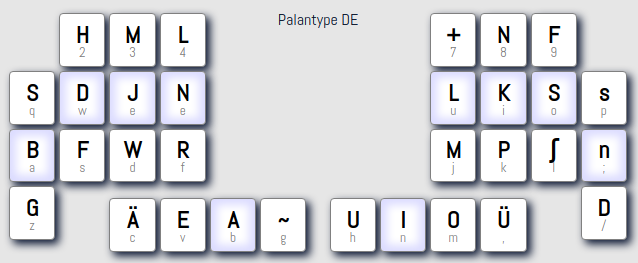Deprecated, this plover plugin moved to Palantype DE.
This is a complete rework of the Possum Palantype steno system for efficient use with the German language. Its intended use is with a keyboard, not an actual Palantype machine. Each finger operates three keys: Home row, top and bottom. The thumbs are exceptions, they operate four keys. There is no simultaneous pressing of multiple keys with one finger.
Like the original Palantype, this adaption is compatible with Qwerty-keyboards as long as they support N-key roll-over (NKRO). The optimal experience is to be expected with an Ergodox keyboard or similar, i.e. a keyboard that allows full use of the thumbs.
Head over to palantype.com to get started right away in the browser.
This is a plugin for the software Plover from The Open Steno Project. Download the latest version of Plover. Plover supports plugins from v4.0.0 on.
After installing this plugin, you need to turn on Palantype in Plover:
- In Plover's configuration, go to the
Systemstab, and change the active system toPalantype DE. - In Plover's machine tab, select
keyboard.
Work in progress
Currently, only the tutorial is implemented at palantype.com. Learning to type requires a lot of practice, therefore it is recommended starting there in any case.
In future, palantype.com will also offer an on-line text editor for steno typing.
The dictionary contains over 100'000 words of the German language. For productive use, a list of over 2'000'000 words has to be included (currently in progress).
Apart from ILKSn to delete the last input, there are no command keys implemented.
- numbers
- arrow keys for navigation
- implement capitalize last word
- paragraph (return key)
- hyphenation of arbitrary words
- ...
The current list of over 100'000 words uses word frequency information to resolve collisions, i.e. ambiguous steno chords. The word frequency information has been provided by the Natural Language Processing Group, Uni Leipzig. It is generated out of a corpus of 35 Million sentences and distributed under the Creative Commons Attribution-NonCommercial 4.0 International Public Licence.
